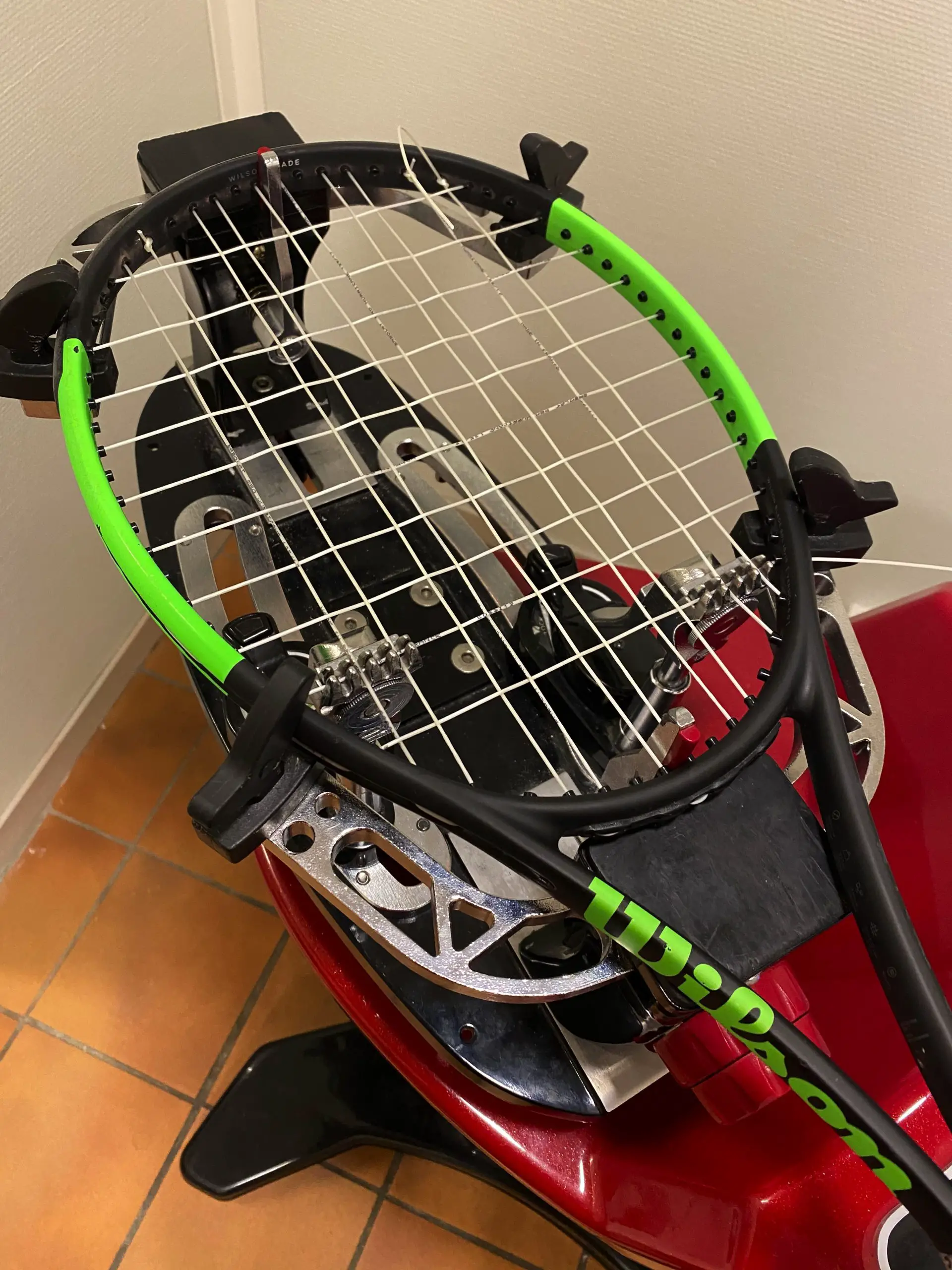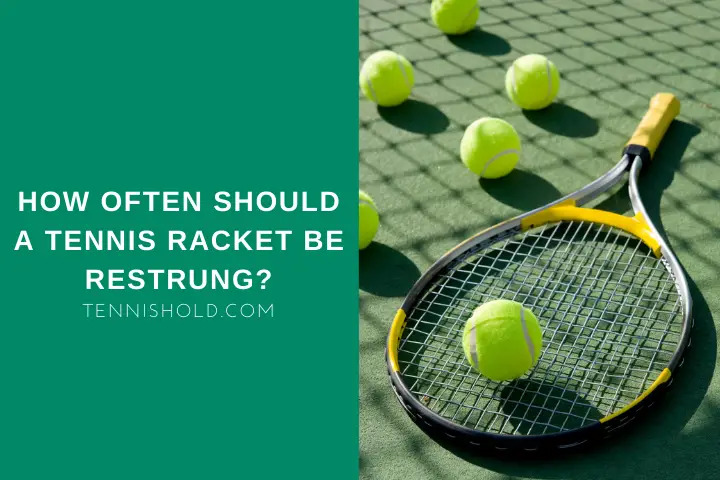Players have different preferences for changing the grip on their racket. Some will wait until it completely disintegrates.
Others will change their grip after each training. In some extreme cases, players will change every time they switch ends.
If you’ve ever watched Richard Gasquet play, you will no doubt have seen him regripping his racket after every change of ends.
What about strings, though? How often should you restring your tennis racket?
Changing strings is a personal choice. If you do not mind losing tension and want to save money, you can wait until they break. If you are a high-performance player concerned about tension loss, you should change the strings every 10-15 hours.
10-15 hours of play is a good guide as it is at this stage that you will usually notice a difference in tension.
In this article I will be discussing:
- How long tennis strings will last
- Knowing when to change strings
- 3 reasons why strings lose tension
- What you will need to restring your racket
Stringing, especially if you don’t have your own machine can become expensive. If you’re unsure whether you need new strings or just want to learn more, read on!
How Long Do Tennis Strings Last?

In the introduction, I mentioned that when to change strings comes down to personal preference.
For measuring how long tennis strings last, I will not consider personal preference. Instead, I will analyze solely when they are no longer suitable to use.
Many different factors affect the lifespan of tennis strings. The first consideration is the frequency of play.
It probably goes without saying, but the more you use your racket, the faster the strings will degrade.
Every time your racket strikes the ball, the strings will weaken. However, if you hit the ball with less spin, you will break the string faster. This is because there is a more direct impact on the strings.
Let’s assume you purchase a new racket. You play with it once and then place it in the cupboard for a year.
After one year, the strings will still be intact. They don’t go stale in the same way food does. They might not feel the same, but they are still usable.
How hard you can hit the ball will also be an influencing factor in the longevity of the strings.
Daniil Medvedev is more likely to break strings in 10 hours of play than a beginner in 100 hours.
The material of the strings is another thing to think about. Some materials last longer than others. Monofilament strings generally offer greater durability than multifilament and synthetic gut.
The natural gut is the best string for maintaining tension. The downside is that it is very soft. This makes it particularly vulnerable to hot temperatures.
If exposed to heat for a long time, the string will become brittle. This will increase the risk of the string breaking.
It is impossible to predict how long strings will last. However, using the factors I have mentioned will give you an idea of the things that influence string longevity.
How Do I Know That Strings Need To Be Changed?

The most obvious answer to this section is when the strings have broken. If the strings have crumbled, there is no option. You can’t play tennis if your racket doesn’t have any strings.
A good time to change if you don’t have a spare racket is just before the strings break.
If you can see the strings are starting to fray, they are thinner, and you feel your shots have much less control than usual, then it is a good time to cut them out and install some new ones.
Tennis players will typically have at least two rackets to cover themselves if a string breaks.
Imagine you have only one racket, and your string breaks in the middle of a match. Then, you are finished unless your opponent is kind enough to lend a racket.
When stringing tennis rackets, you can use this formula for measuring power vs. control. The higher the tension, the more control. The lower the tension, the more force.
As string tension reduces, you will lose control of your shots. So if you feel that you don’t have enough control as you hit, it could be a good time to get the racket restrung.
Another indication is if there is a lot of movement between the strings. This is another sign of tension loss.
When the strings have just been applied it will be harder to move them. Once they have lost tension it won’t take much to get them falling in and out of position.
Why Do Strings Lose Tension?

Several factors lead to strings losing tension. I’ve covered a few of them already, but I will go into more detail here.
Time
If you string your racket at 60 lbs and leave it in a cupboard for a year, it will lose tension. It may seem strange that a string can lose tension when not being used.
As soon as a racket comes off the stringing machine, it has recently had tension applied.
As the strings are no longer on the machine, there is nothing to force it to maintain tension anymore. It will therefore begin to lose tension.
Some tennis strings will lose as much as 10% of their tension within 24 hours of being restrung.
Impact
Every time your racket contacts the ball, it will weaken the strings. Also, as mentioned earlier, hitting flat shots will weaken the strings more.
Hitting with topspin or slice will still cause them to decline.
As the ball hits the strings, it creates a trampoline effect. The ball will land on the bed of strings pull back slightly before coming forwards again.
As the trampoline effect takes place, it pulls the strings out of position. When the strings move out of position, they will gradually lose tension.
Racket damage
An area that is often overlooked is racket damage. The most common reason beginners break strings is due to this.
When players are hitting the ball low to the ground, they will sometimes clip their racket on the court.
When this happens, it doesn’t just damage the frame but the strings too. If you slice the ball and your racket catches the ground, it can weaken and even break the string.
Deliberate or damage caused in anger will have the same effect. If you throw your racket at the ground, it will weaken the frame and expose the strings more.
What Equipment Do I Need For Restringing The Racket?

Unfortunately, there is no DIY fix if you break your strings. The only option you have is to restring it with a stringing machine.
String machines available vary hugely. One of the best machines on the market is the Wilson Baiardo.
The Baiardo is popular because it is an electric machine, but it also allows stringers to have different profiles.
On these profiles, they include their height. When you log in to your profile, the machine’s elevation will adjust according to the height of the stringer.
If you are just looking to string your own racket, a Baiardo will probably be too expensive.
You can come across tabletop machines for as little as $250.
In addition to the machine, you will need clippers to cut the string.
Final Words
There is no guarantee for how long tennis strings will last. When to restring the racket is also a decision only you can make.
But if you are concerned about the loss of tension, it won’t hurt to restring regularly.
How often do you restring your racket? Perhaps you wait until the string has broken. I do that.
I like that challenge of seeing how fast I can break the strings.

